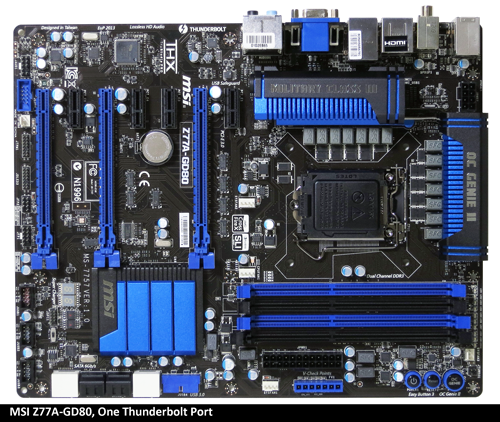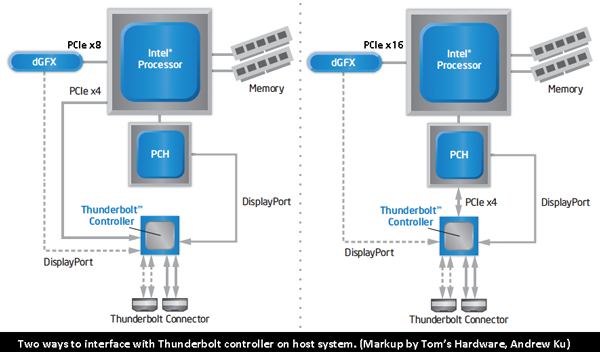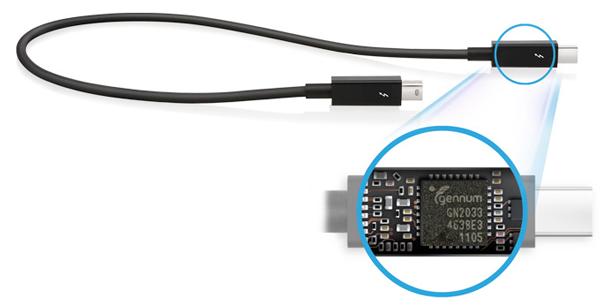Everything You Need To Know About Thunderbolt
Thunderbolt Finds Its Way To PCs
Mac and PC users are never going to agree on which platform has the best operating system. But when it comes to hardware, though, the PC world has an undisputed advantage. We have a lot more choice when we pick our processors, graphics cards, and motherboards. If you're using a Mac, you have to wait for Apple to add driver support for the device you want (if it ever happens at all).
Thunderbolt violates the rule that PCs get the coolest technologies first. For almost a year, Mac users have been enjoying the Thunderbolt, which was developed by Intel, because of collaboration from Apple. Power users with PCs were forced to sit and wait, though a dearth of client devices made it more tolerable to watch the Mac guys get their hands wet with Thunderbolt.
MSI recently released the first available motherboard with Thunderbolt support, its Z77A-GD80, ending Apple’s monopoly on what could be considered the coolest interface since the original USB standard. The platform we received is essentially identical to the Z77A-GD65 we reviewed in Six $160-220 Z77 Motherboards, Benchmarked And Reviewed, aside from a 10 Gb/s Thunderbolt port on the rear I/O panel (replacing DVI output), along with a new 14-phase voltage regulator.
If you aren't yet familiar with Thunderbolt or its implications, we definitely believe that the technology is an interface you're going to want on the next system you put together, even if the ecosystem of compatible devices remains fairly small today.
Of course, Thunderbolt is a name for an Intel initiative originally code-named Light Peak—an optical physical layer used to connect peripherals. Back when Intel first showed off its Light Peak project at IDF 2009, it was thought that optical would enable 10 Gb/s throughput. However, a version employing copper wiring turned out better than expected, allowing Intel to drop costs and deliver up to 10 W of power to attached devices.
The big objection from most enthusiasts is going to be that we already have USB 3.0 showing up as a value-added extra in AMD and Intel chipsets. Why do we need to pay for yet another interface? After all, at 5 Gb/s, a third-gen USB port is almost able to accommodate the peak performance of a modern SSD. Thunderbolt isn't just another peripheral interface, though. It combines DisplayPort and PCI Express into a serial data stream, enabling very powerful connectivity combinations (along with innovative product ideas like MSI's GUS II).
Manufacturers have toyed with USB-based graphics expansion over the years, but none truly succeeded because USB’s unique command set simply wasn't designed to facilitate high-performance graphics I/O. However, Thunderbolt’s low-latency/high-bandwidth interface is, however, making it a robust transport technology with extremely accurate time synchronization support that's ideal external video and audio devices.
Get Tom's Hardware's best news and in-depth reviews, straight to your inbox.
How Does Thunderbolt Work?
Systems with Thunderbolt controllers will attached them one of two ways: either it's attached directly to PCI Express links originating from a Sandy or Ivy Bridge-class processor, or it derives connectivity from a Platform Controller Hub's available PCIe.
We suspect that, on the desktop, most motherboard vendors will hook up through the PCH in order to avoid monopolizing processor-based lanes, which are generally needed for add-in graphics. Such a configuration does open up the potential for a bottleneck, since the DMI connection between processor and chipset is theoretically good for around 2 GB/s of bi-directional throughput. If you have a lot of SATA-attached storage cranking away, it's conceivable that the maximum performance of Thunderbolt could be constrained.
In the image above, you can see that DisplayPort data routes between the Thunderbolt controller and the PCH's Flexible Display Interface, since that's where display connectors attach. The FDI is its own pathway, specifically reserved for carrying display information, and it does not impact the bandwidth available through DMI 2.0.
PCIe and DisplayPort signals enter the Thunderbolt controller separately, are multiplexed, travel through a Thunderbolt cable, and are de-multiplexed at the other end.
Thunderbolt requires active cables, which is why they're so expensive (in the $50 range). Each cable end sports two tiny, low-power Gennum GN2033 transceiver chips that are responsible for boosting the signal passing through to enable 10 Gb/s data rates over runs as long as three meters.
Originally, Thunderbolt was going to be enabled using an optical physical layer and optical fiber cabling. But Intel discovered that it could achieve its 10 Gb/s per channel target at a lower cost using copper wiring. Plans for an optical-based implementation are still on the table, and we expect to see optical cables enabling even longer-distance connections in the future. As we already mentioned, though, copper cabling delivers up to 10 W of power to attached devices. When optical cables do emerge, attached devices will require their own power supplies.
Despite Thunderbolt's many unique attributes, the interface shares certain capabilities with other technologies. For example, it supports hot-plugging. And, like FireWire, it is designed to work in daisy chains. Machines that come armed with Thunderbolt will either include one or two ports, each supporting up to seven chained devices, two of which can be DisplayPort-enabled monitors. So, you end up with the ability to attach:
- Five devices and two Thunderbolt-based displays
- Six devices and one Thunderbolt-based display
- Six devices and one display via mini-DisplayPort adapter
- Five devices, one Thunderbolt-based display, and one display via mini-DisplayPort adapter
Of course, daisy-chaining requires that each device (except for the last one) has two Thunderbolt ports. So, when you attach a display that doesn't have a Thunderbolt port, necessitating a mini-DisplayPort adapter, or only has one port, there is no way to pass the signal on to the next device in the chain. As such, displays go to the end when you're linking multiple components.
The Thunderbolt connector itself is physically compatible with mini-DisplayPort, so turning the connector into a display output is particularly easy.
Are there caveats to putting PCIe and DisplayPort data on the same cable? In theory, no. Apple and Intel resolved early display quality issues encountered on early hardware through a firmware update in 2011. The interface employs two data channels, each capable of pushing 10 Gb/s in each direction. The solution used one channel for device I/O and the other for display signaling. Even still, we cite 10 Gb/s as Thunderbolt's official spec, since performance is not additive.
Current page: Thunderbolt Finds Its Way To PCs
Next Page Thunderbolt's Bandwidth: Sizing Up To USB 3.0, FireWire, And eSATA-
mayankleoboy1 for more insight of thunderbolt fail and Intel's lying :Reply
http://semiaccurate.com/2012/06/06/intel-talks-about-thunderbolt/ -
shoelessinsight Active cables are more likely to have defects or break down over time. This, plus their high expense, is not going to go over well with most people.Reply -
mayankleoboy1 ^Reply
because "thunderbolt" sounds much sexier than "HDBaseT " ?
and with apple, its all about the sexiness, not functionality/practicality. -
JOSHSKORN Prediction: We will see Thunderbolt available on SmartPhones. When we do, this port will be able to handle a monitor, external hard drives, speakers and many other USB devices through its Thunderbolt docking station. Obviously a SmartPhone won't need to be attached to a webcam. This will become the future desktop...that is, if it can run Crysis. LOL Had to add that in there. :)Reply -
pepsimtl I remenber scsi interface ,so expensive ,just the company (server) use it .Reply
and sata interface replace it.
For me Thunderbolt is the same song
I predict a sata 4 (12gb) or usb 4 ,soon







